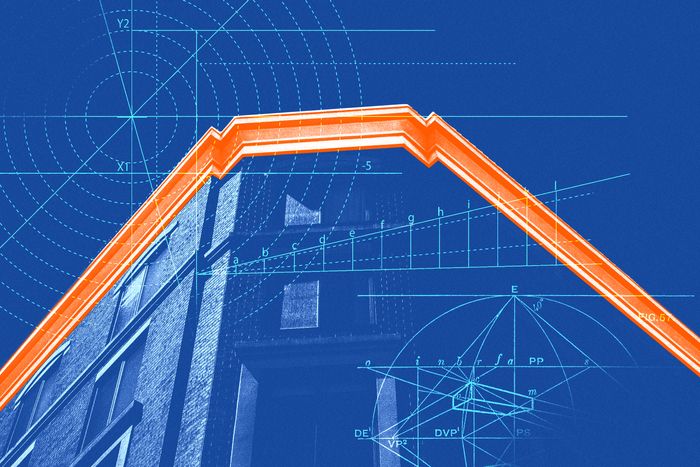
Homeowners in Brownstone Brooklyn are anxious about their rooflines. “Someone was giving out flyers today on my block … about ‘mandatory’ parapet wall inspections,” one wrote on a Brownstoner forum. “Just got a flyer hung on our doorknob from what appears to be a brand-new company called Parapet Pros (“COMPLIANCE UNLEASHED”) with scare language (“You could face fines for each month your report is overdue”) that might be totally made up,” another worried. The borough’s many propertied residents say they’ve been inundated in recent months with calls and emails from parapet-inspection companies urging them to schedule an inspection before it’s too late. “These companies are flyering around and calling people and creating this sense of urgency,” says Lara Birnback, the executive director of the Brooklyn Heights Association. “I’ve definitely had people contact me and ask, ‘Is this legitimate?’”
Well, yes and no. There is indeed a new parapet-inspection law mandating annual inspections of parapets, low walls that run along the edge of a roof, on buildings regardless of height. And yes, the deadline for these inspections is the rapidly approaching January 1. But there’s a considerable amount of confusion among homeowners who say they don’t know what exactly qualifies as a parapet (one limestone-townhouse owner in Prospect–Lefferts Gardens wondered if an exposed, lot-line roof wall counted. And what of cornices, especially if the roof slopes up to them in a wall-like fashion?), or who can inspect it (the Department of Buildings says anyone “competent to inspect parapets,”), or what exactly happens if they haven’t done one by the New Year.
“When I heard about it, I was very confused,” says Tim Pietrzak, who owns a South Slope rowhouse. “The definition of parapet is kind of ambiguous. All the buildings on my block have big cornices that extend three feet; does that count as a parapet or not?” There are also exceptions — among them, the law applies only to parapets fronting public right-of-way, so if you have sufficient a setback from the sidewalk, you don’t need an inspection. Pietrzak says his house, like many others in New York, has a little front yard behind a gate. But it’s only 12 feet, not the 15 he believes he’d need. He is, however, pretty sure he doesn’t have a parapet: His house is in the middle of a row, and he recently bumped into an architect who lives nearby and gave him the vague assurance that what he had “wasn’t really a parapet.”
To cover his bases, though, he planned to go up and take a look himself — years ago, he worked as a super, and supers are included in the DOB’s description of “competent” parapet inspectors alongside handymen, bricklayers, masons, architects, and engineers.
Why does anyone have parapets? Besides roof-sealing, parapets stop people from accidentally falling off the edge of the roof and provide a firebreak between rowhouses. And they really can be dangerous if not maintained: Since January 2014, there have been 434 non-construction-related incidents involving parapets in the five boroughs with about 25 percent of those resulting in injuries or fatalities, according to the DOB. The incidents include “falling bricks, structural stability concerns due to major cracks forming at the parapets, leaning parapets, partial parapet collapses, and full parapet collapses.”
Hence the new inspection requirement in the revised 2022 construction code. “We tried to keep the parapet-inspection process as simple as possible,” Yegal Shamash, the DOB’s deputy commissioner of enforcement, tells me in a recent call. “It can be done by any competent person — a super or a handyman, a mason, a bricklayer, the homeowner themselves if they’re competent. You don’t have to spend thousands of dollars to have it done. It’s a visual inspection — no testing, no probes. It can be done from the roof or the fire escape. We’re not even asking for the homeowner to file it with the department, just to keep it on hand for the next six years.”
There is, Shamash adds, no civil penalty for failure to comply (though should there be an incident, the building owner would be expected to produce the reports and might incur a violation if they haven’t done them). “I think the confusion lies in people thinking this is part of Local Law 11 or the Façade Inspection & Safety Program,” he says. FISP, a much more intensive requirement, applies to buildings over six stories and requires an inspection done by an architect or engineer with special qualifications every five years. And to allay the fears of brownstone-dwellers: A cornice is not a parapet, so most brownstones don’t actually have parapets. “If a wall extends up from the cornice, it would be a parapet, but the historic-building codes exempted you from having a parapet if you had a cornice, so most brownstones will not,” says Shamash.
And it’s true enough that there’s some opportunistic marketing going on. The DOB says that earlier this year, it had to send cease-and-desist letters to a company using its logo to drum up business. Others seem to be doing their best to induce panic. “Act fast,” advises the website of Parapet Pros, warning building owners that failure to comply with the DOB’s new parapet-inspection law “not only risks the safety of your occupants, but exposes you to severe financial penalties.” Scroll down and there are the thousands of dollars in fines that violators may be subject to, while a countdown clock on the bottom of the page shows just how many days, hours, and seconds are left until the January 1 deadline.
Warning of $5,000 fines for failing to file the initial report and $1,000 every month thereafter, the website describes them as “examples of fines from Local Law 11 Commercial & Local Law 126 Garages,” but a reader scanning would assume they’re for parapet inspections. When I called the company, the woman who answered told me that inspection prices start around $449 and the inspections are done by engineers and contractors — people qualified to inspect them. She couldn’t tell me much else but promised to pass my questions on to the manager, who didn’t call back.
“They’re blanketing the city,” Josh Blackman, the CEO of Brownstone Property Group, which manages more than 130 buildings in New York, says of the flyering he has seen in response to the regulations. “These kinds of laws are necessary, but they generate an industry for the inspectors.” This, he admits, includes his company, which charges $495 for clients and $650 for non-clients, though he adds that it’s one of many services Brownstone offers, so it’s not out flyering or taking advantage of cornice confusion to make people get inspections they don’t need.
But this kind of thing apparently comes with the territory. “It’s not surprising that people are trying to capitalize on something that’s unclear,” says Birnback of the Brooklyn Heights Association. “They’re hardly the only ones trying to take advantage.” Pietrzak, the South Slope homeowner, says he regularly fields calls from sidewalk- and chimney-inspection companies. “The chimney-inspection companies are crazy. They call all the time, wanting to replace the flue in your chimney. The sidewalk guys also call all the time.” Now, the parapet guys are calling, too.


